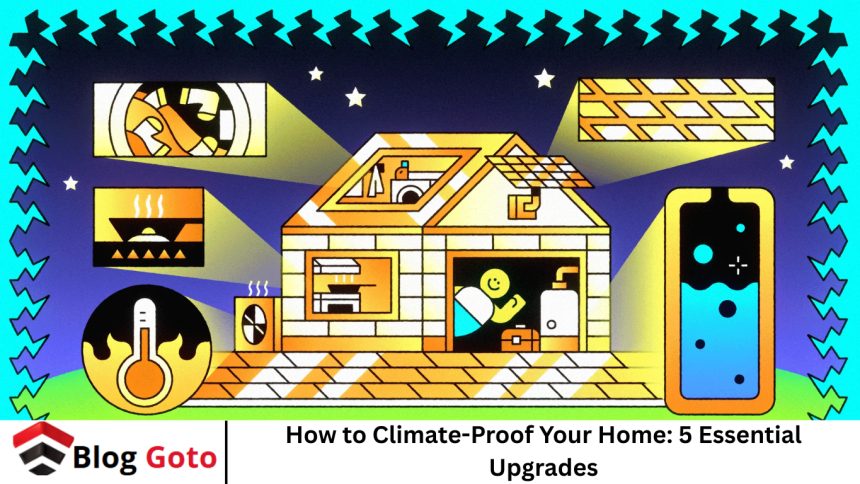As the effects of climate change continue to intensify—bringing with them extreme weather events like hurricanes, floods, wildfires, and heatwaves—our homes are increasingly vulnerable to damage and disruption. It’s no longer just a matter of comfort or efficiency. Climate-proofing your home is about safety, resilience, and long-term savings.
Whether you’re building a new house or upgrading an existing one, taking strategic steps to climate-proof your space will help protect your family and your investment in the years to come. In this guide, we’ll explore five essential upgrades to climate-proof your home, with practical tips, material suggestions, and expert advice to ensure your house is ready for whatever Mother Nature throws your way.
Climate change is no longer a distant threat—it’s a present-day reality affecting how we live, work, and protect our homes. From scorching heatwaves and torrential rains to devastating wildfires and rising sea levels, extreme weather events are becoming more frequent and intense.
More Read: Which Active Breaks Work Best to Counter a Sedentary Lifestyle?
Upgrade Your Insulation and Windows for Temperature Extremes
Why it matters:
Insulation and windows are your home’s first line of defense against temperature extremes. In summer, they keep heat out; in winter, they retain warmth. As climate change leads to longer heatwaves and unexpected cold snaps, thermal efficiency becomes vital.
What to do:
- Install high-performance insulation: Upgrade to R-value-rated insulation that suits your region’s climate. Use spray foam or blown-in cellulose in walls and attic spaces.
- Seal leaks: Use caulking or weatherstripping around doors and windows to reduce drafts.
- Replace windows with double- or triple-glazed panes: These windows trap air or inert gas between layers to reduce heat transfer.
- Choose low-E (low-emissivity) glass: It reflects heat while still allowing light, reducing energy use and UV damage to interiors.
Benefits:
- Lower heating and cooling costs
- Improved indoor comfort
- Reduced carbon footprint
Install Flood Protection Systems
Why it matters:
Flooding is one of the most common and expensive natural disasters—especially in coastal or low-lying areas. Climate change is increasing both rainfall intensity and sea-level rise.
What to do:
- Install a sump pump in your basement to remove excess water.
- Elevate electrical systems such as switches, sockets, and appliances above potential flood levels.
- Use flood barriers or sandbags during storms, or invest in more permanent flood skirts and door shields.
- Backflow valves on sewer lines can prevent sewage from backing up into your home.
Benefits:
- Prevents structural and water damage
- Protects against mold and mildew
- Helps maintain insurance eligibility
Reinforce the Roof and Exterior for Wind and Fire Resistance
Why it matters:
Roofs and exteriors are vulnerable to high winds and wildfires. Hurricanes, tornadoes, and severe windstorms are increasing in frequency and strength. Similarly, wildfires now affect areas that were once considered safe.
What to do:
- Use fire-resistant roofing materials like metal, tile, or asphalt shingles with a Class A fire rating.
- Secure roof-to-wall connections using hurricane clips or straps.
- Install wind-resistant windows and shutters designed to withstand impacts.
- Trim vegetation and clear gutters to reduce fire fuel around the home.
Install ember-resistant vents that block wind-driven sparks from entering attics and crawlspaces.
Benefits:
- Reduces damage during storms or fires
- Lowers insurance premiums
- Increases home valu
Invest in Smart Water Management
Why it matters:
Droughts and water shortages are becoming more common, but so are flash floods. Managing water both inside and outside your home helps create a sustainable, climate-resilient environment.
What to do:
- Install a rainwater harvesting system to collect and reuse water for gardening or flushing toilets.
- Add permeable pavers or gravel walkways to allow water to seep into the ground instead of flooding storm drains.
- Use native landscaping or xeriscaping to reduce irrigation needs.
Upgrade to water-efficient fixtures like dual-flush toilets, low-flow showerheads, and smart irrigation controllers.
Benefits:
- Reduces water bills
- Helps manage stormwater runoff
- Conserves resources in drought-prone areas
Solar Power and Backup Energy Systems
Why it matters:
Climate-related disruptions to power grids are increasingly common. Blackouts caused by wildfires, storms, and heatwaves are no longer rare. Having a self-sufficient energy system is essential for safety and continuity.
What to do:
- Install solar panels to harness renewable energy and lower dependence on fossil fuels.
- Use a battery storage system (like Tesla Powerwall) to store excess power for use during outages.
- Upgrade to smart home systems that optimize energy use based on weather conditions.
- Consider a backup generator, especially in areas prone to frequent outages.
Benefits:
- Reduces electricity costs
- Ensures continuous power during emergencies
- Decreases reliance on carbon-intensive power grids
Additional Tips for Climate-Proofing
- Regular maintenance: Clean gutters, service HVAC systems, and inspect roofs and windows annually.
- Build higher: If you’re renovating or constructing new, elevate the foundation to protect from floods.
- Community planning: Advocate for resilient public infrastructure in your neighborhood.
- Insurance: Make sure your coverage reflects current climate risks, including flood and wildfire protection.
Frequently Asked Question
What does it mean to climate-proof a home?
Climate-proofing a home involves making structural and system upgrades that protect it from climate-related hazards like floods, wildfires, extreme temperatures, and power outages. It’s about building resilience, conserving resources, and improving long-term sustainability.
How much does it cost to climate-proof a home?
Costs vary depending on the scope of the upgrades. Basic weatherproofing might cost a few hundred dollars, while installing solar systems or retrofitting for flood and wind resistance can cost several thousand. However, many improvements qualify for tax credits and reduce future damage-related expenses.
Is it possible to climate-proof an older home?
Yes. While new homes can be built with resilient materials from the ground up, older homes can still be retrofitted with insulation, window upgrades, sump pumps, and solar panels. Even small changes like sealing cracks or adding shading devices can improve resilience.
Do climate-proof upgrades increase property value?
Absolutely. Buyers are increasingly aware of climate risks and are willing to pay more for homes that are energy-efficient, disaster-resilient, and lower-maintenance. Green certifications and solar installations can be especially attractive.
What government incentives are available?
Many countries offer tax credits, rebates, and low-interest loans for climate-resilient upgrades, including:
- Energy-efficient windows and insulation
- Solar power installations
- Storm-resistant roofing
Check local utility companies and federal programs like the U.S. Inflation Reduction Act or similar initiatives in your region.
Can I DIY some of these climate-proofing strategies?
Yes. Some upgrades like weatherstripping, installing low-flow fixtures, or laying permeable materials are beginner-friendly. However, electrical, roofing, or structural work should be done by professionals to ensure safety and compliance with building codes.
How do I know what my home needs?
Start with a home energy and risk audit. Many local utilities or green building consultants offer assessments that identify weaknesses, prioritize upgrades, and suggest custom solutions based on your location, home age, and exposure to climate risks.
Conclusion
Climate change is no longer a distant concern—it’s already reshaping the way we live, and our homes must adapt accordingly. By investing in the five essential upgrades covered here—insulation and windows, flood protection, exterior reinforcement, smart water management, and renewable energy—you’re not just reacting to the environment, but proactively protecting your family, your finances, and your future. Climate-proofing your home isn’t about fear—it’s about foresight. Every step you take today strengthens your home for tomorrow.











